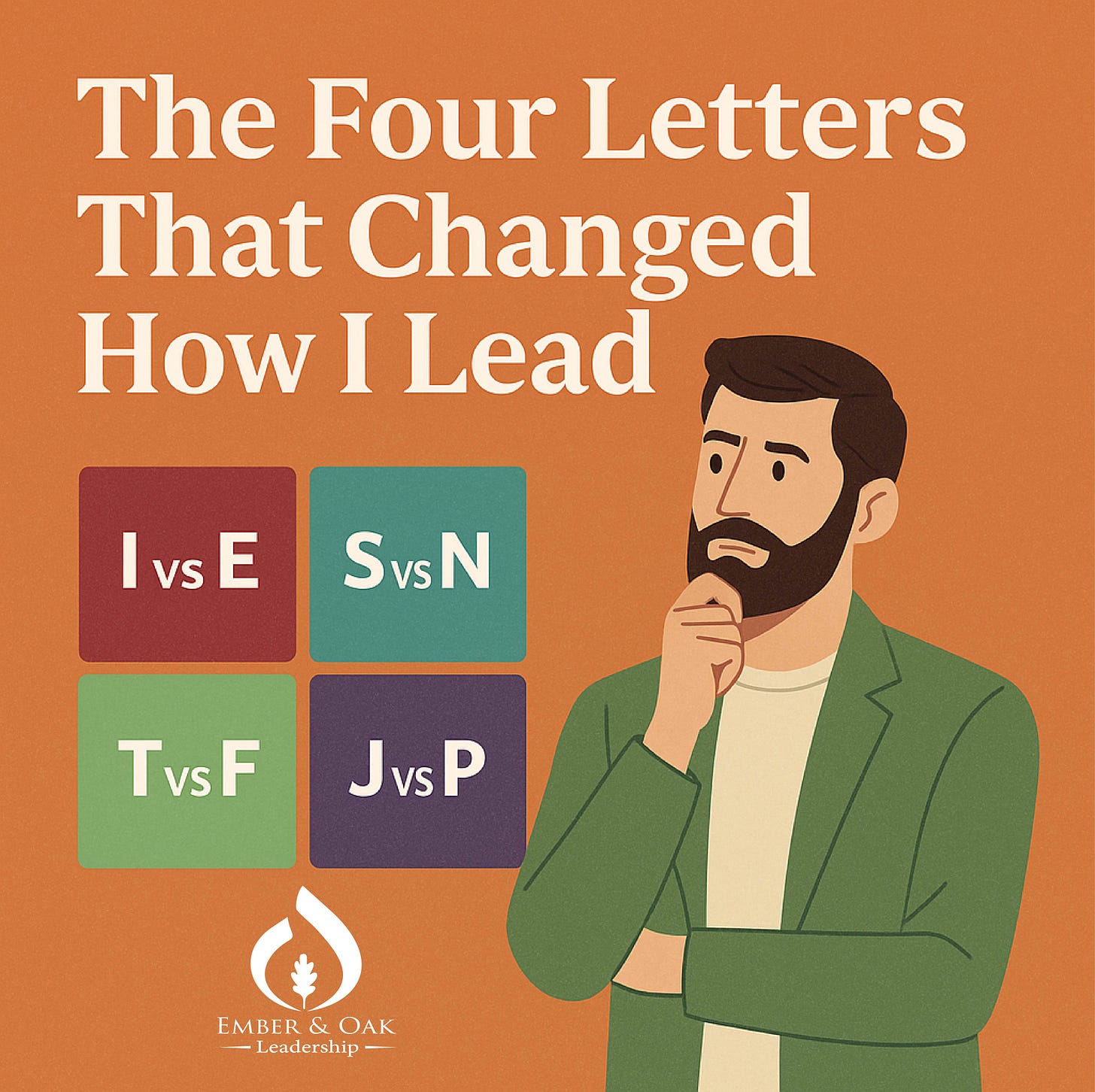The Four Letters That Changed How I Lead
What the MBTI taught me about feedback, leadership, and building stronger teams
One of the first things I do when I take over a new team isn’t reviewing organizational charts or checking metrics. Instead, I ask people to take a personality test.
Not because I believe in rigid categories, but because I want insight. I want to know how each person sees the world, where they get their energy, how they make decisions, and what structure (or lack of it) helps them thrive.
The tool I use? The MBTI framework, also known as the 16 Personalities.
You’ve probably heard of it before. It breaks people down into four letter pairs:
Introvert (I) or Extravert (E)
Sensing (S) or Intuition (N)
Thinking (T) or Feeling (F)
Judging (J) or Perceiving (P)
Each pair tells a story. When you read the entire profile, the story evolves into a leadership roadmap. Below, I’ll guide you through each letter, not from a psychological perspective, but from a practical, boots-on-the-ground leadership viewpoint.
I vs. E: Where Energy Begins
Introverts (I) recharge through quiet focus. They prefer time to think, space to reflect, and depth over chatter.
Leadership tip: Don’t assume silence means disengagement. Give them time to process.
Feedback tip: Written or one-on-one feedback works best, especially when it’s thoughtful and specific.
Extraverts (E) think out loud. They process by talking, collaborating, and staying in motion.
Leadership tip: Give them the room to brainstorm and lead conversations.
Feedback tip: They prefer in-the-moment, spoken feedback with opportunities to respond and engage.
S vs. N: How People Take in Information
Sensors (S) trust facts, step-by-step instructions, and hands-on data. They’re present-focused and detail-driven.
Leadership tip: Be clear, concrete, and realistic in your expectations.
Feedback tip: Show them results. “You improved output by 25%” goes a long way.
Intuitives (N) are vision-focused and drawn to patterns. They live in the future and connect abstract ideas.
Leadership tip: Give them freedom to innovate.
Feedback tip: Frame your message around meaning and big-picture impact.
T vs. F: What Drives Decisions
Thinkers (T) make decisions based on logic, fairness, and consistency.
Leadership tip: Be direct, rational, and efficient in how you delegate and correct.
Feedback tip: Keep it objective. Thinkers want to know what worked and what didn’t, without the fluff.
Feelers (F) are guided by values, empathy, and connection. They’re attuned to group dynamics and care deeply about how decisions affect others.
Leadership tip: Make space for emotions. Show appreciation frequently.
Feedback tip: Lead with care. Acknowledge effort and intent as much as results.
J vs. P: Structure vs. Flexibility
Judgers (J) thrive on planning, closure, and predictability. They like checking boxes and meeting deadlines.
Leadership tip: Set clear roles and expectations.
Feedback tip: Be organized, direct, and future-oriented: “Here’s what’s next.”
Perceivers (P) operate best with flexibility and spontaneity. They like to explore and adapt as they go.
Leadership tip: Avoid rigid micromanagement. Give them room to find their path.
Feedback tip: Focus on possibilities: “What do you want to try next?”
Why I Keep Coming Back to MBTI
Personality tools aren’t perfect. They aren’t predictive, and they can’t tell you everything. However, they do initiate a conversation that helps leaders adjust their approach, build deeper trust, and communicate with intention.
In feedback-heavy environments like mine, this is important. You can’t provide great feedback if you don’t understand how someone receives it.
If you're looking for a way to begin with your team, this is it. Have them take the 16 Personalities assessment. Not to label, but to learn.
Leadership starts with understanding, and feedback flourishes when you communicate in someone’s language.
About the Author
Clayton Thompson, Ph.D., is a Colonel in the U.S. Air Force with over 20 years of leadership experience. He is the author of the upcoming book RA-RA Feedback: It’s Not a Moment. It’s a System! for building trust, accelerating growth, and creating a leadership advantage.
Call to Action
Want more tools like this?
I share weekly insights on leading with clarity, giving better feedback, and building teams that grow together. If you found this helpful, subscribe below and share this post with another leader who wants to level up their communication.

